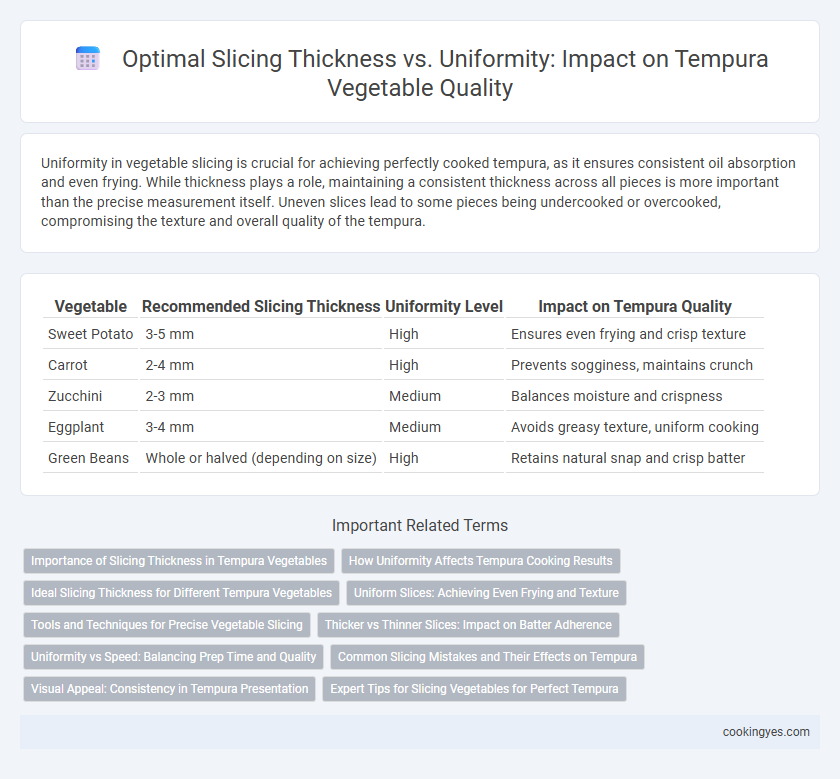Uniformity in vegetable slicing is crucial for achieving perfectly cooked tempura, as it ensures consistent oil absorption and even frying. While thickness plays a role, maintaining a consistent thickness across all pieces is more important than the precise measurement itself. Uneven slices lead to some pieces being undercooked or overcooked, compromising the texture and overall quality of the tempura.
Table of Comparison
| Vegetable | Recommended Slicing Thickness | Uniformity Level | Impact on Tempura Quality |
|---|---|---|---|
| Sweet Potato | 3-5 mm | High | Ensures even frying and crisp texture |
| Carrot | 2-4 mm | High | Prevents sogginess, maintains crunch |
| Zucchini | 2-3 mm | Medium | Balances moisture and crispness |
| Eggplant | 3-4 mm | Medium | Avoids greasy texture, uniform cooking |
| Green Beans | Whole or halved (depending on size) | High | Retains natural snap and crisp batter |
Importance of Slicing Thickness in Tempura Vegetables
Optimal slicing thickness in tempura vegetables directly impacts cooking uniformity and texture, with 2-4 mm slices balancing crispiness and tenderness. Uniform thickness ensures even oil absorption and frying speed, preventing undercooked or soggy areas. Precise slicing enhances presentation and mouthfeel, showcasing the ideal tempura crunch.
How Uniformity Affects Tempura Cooking Results
Uniform vegetable slicing thickness is crucial for achieving evenly cooked tempura, as inconsistent thickness causes uneven frying, leading to some pieces being undercooked while others become overly crispy or soggy. Maintaining uniformity ensures consistent heat penetration, resulting in a light, crispy tempura batter that complements the tender vegetable interior. Precision in slicing thickness enhances the overall texture and flavor balance, making the tempura visually appealing and enjoyable.
Ideal Slicing Thickness for Different Tempura Vegetables
Ideal slicing thickness for tempura vegetables ensures even cooking and crisp texture; root vegetables like sweet potatoes and carrots benefit from slices about 3-4 mm thick, while softer vegetables such as bell peppers and eggplants require thinner slices near 2-3 mm. Uniform thickness prevents uneven frying, avoiding undercooked centers or overly soggy coatings. Consistent slicing also enhances presentation and maintains the delicate balance of tempura's signature light, crispy batter.
Uniform Slices: Achieving Even Frying and Texture
Uniform slices in tempura vegetables ensure consistent frying times, resulting in an evenly crispy texture and preventing undercooked or burnt spots. Optimal thickness typically ranges between 2 to 4 millimeters, balancing quick heat penetration with structural integrity. Maintaining precise thickness uniformity enhances the visual appeal and delivers a harmonious, satisfying crunch in every bite.
Tools and Techniques for Precise Vegetable Slicing
Using a mandoline slicer with adjustable thickness settings ensures uniform vegetable slices for consistent tempura cooking. High-quality Japanese knives like a yanagiba provide excellent control for precise hand slicing, maintaining even thickness. Implementing proper slicing techniques and tools minimizes moisture loss and promotes optimal batter adhesion, resulting in perfectly crispy tempura vegetables.
Thicker vs Thinner Slices: Impact on Batter Adherence
Thicker vegetable slices for tempura provide a firmer texture and better structural support, allowing the batter to adhere more evenly without becoming soggy. Thinner slices, while crispier after frying, risk uneven batter coverage and potential detachment due to their delicate surface area. Uniform slicing thickness ensures consistent frying times, optimal batter adhesion, and balanced moisture retention for perfect tempura vegetables.
Uniformity vs Speed: Balancing Prep Time and Quality
Uniform vegetable slicing thickness is crucial for tempura to ensure even frying and consistent texture, while maintaining preparation speed affects kitchen efficiency. Prioritizing uniformity slightly over speed prevents uneven cooking and soggy spots, preserving the signature crispness and delicate flavor of tempura vegetables. Achieving a balance between precise cuts and timely prep optimizes both quality and operational workflow in tempura preparation.
Common Slicing Mistakes and Their Effects on Tempura
In tempura preparation, inconsistent vegetable slicing thickness leads to uneven cooking, causing some pieces to be undercooked while others become overly crispy or burnt. Common slicing mistakes such as irregular thickness or jagged edges disrupt the batter's adherence and result in an uneven texture after frying. Achieving uniform, thin slices ensures quick, even frying, producing the ideal light and crispy tempura vegetable texture.
Visual Appeal: Consistency in Tempura Presentation
Uniform vegetable slicing thickness enhances the visual appeal of tempura by creating a consistent golden-brown crust across all pieces. Precise, evenly cut slices ensure uniform cooking, preventing uneven browning and textural contrast that can detract from presentation. Consistency in slice thickness contributes to a professional, appetizing tempura display admired in high-end Japanese cuisine.
Expert Tips for Slicing Vegetables for Perfect Tempura
Achieving the perfect tempura texture requires slicing vegetables to a uniform thickness of about 3-5mm, ensuring even cooking and crispiness. Experts recommend using a sharp knife to maintain consistent slices, preventing uneven frying and sogginess. Uniformity in thickness enhances batter adhesion and results in a visually appealing, perfectly golden tempura.
Vegetable slicing thickness vs uniformity for tempura vegetables Infographic

 cookingyes.com
cookingyes.com